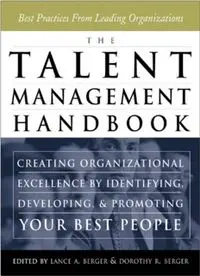
The Talent Management Handbook PDF
Preview The Talent Management Handbook
BergerFM.qxd 8/20/2003 3:43 PM Page i The Talent Management Handbook Creating Organizational Excellence by Identifying, Developing, and Promoting Your Best People This page intentionally left blank. BergerFM.qxd 8/20/2003 3:43 PM Page iii The Talent Management Handbook Creating Organizational Excellence by Identifying, Developing, and Promoting Your Best People Lance A. Berger Dorothy R. Berger McGraw-Hill New York Chicago San Francisco Lisbon London Madrid Mexico City Milan New Delhi San Juan Seoul Singapore Sydney Toronto ebook_copyright 6x9.qxd 10/24/03 11:58 AM Page 1 Copyright © 2004 by The McGraw-HIll Companies, Inc. All rights reserved. Manufactured in the United States of America. Except as permitted under the United States Copyright Act of 1976, no part of this publication may be reproduced or distributed in any form or by any means, or stored in a data- base or retrieval system, without the prior written permission of the publisher. 0-07-143612-X The material in this eBook also appears in the print version of this title: 0-07-141434-7. All trademarks are trademarks of their respective owners. Rather than put a trademark symbol after every occurrence of a trademarked name, we use names in an editorial fashion only, and to the benefit of the trademark owner, with no intention of infringement of the trademark. Where such designations appear in this book, they have been printed with initial caps. McGraw-Hill eBooks are available at special quantity discounts to use as premiums and sales pro- motions, or for use in corporate training programs. For more information, please contact George Hoare, Special Sales, at DOI Page 6x9 10/2/02 1:33 PM Page 1 Want to learn more? , We hope you enjoy this McGraw-Hill eBook! If you d like more information about this book, its author, or related books and websites, please click here. BergerFM.qxd 8/20/2003 3:43 PM Page v For more information about this title, click here. Contents Preface ix Contributors xii Part I Introducing a Talent Management System 1 1. Creating a Talent Management System for Organization Excellence: Connecting the Dots, Lance A. Berger 3 2. Four Steps to Creating a Talent Management System, Lance A. Berger 22 3. The Journey to Organization Excellence: Navigating the Forces Impacting Talent Management, Dorothy R. Berger 34 4. A Talent Management Case Study: Major League Baseball’s Quest for Superkeepers, William Y. Giles 45 Part II Developing the Building Blocks of Talent Management: Competencies, Performance Management, Career Track Planning 51 Building Block 1. Competencies 5. Competencies: The First Building Block of Talent Management, Murray M. Dalziel 53 6. How Competencies Create Economic Value, Lyle M. Spencer, Jr. 64 Building Block 2, Performance Management 7. Selecting the Right Performance Management System, Martin G. Wolf 85 8. Performance Appraisal: Myth and Reality, Christian M. Ellis and Anne M. Saunier 104 v Copyright 2004 by The McGraw-Hill Companies, Inc. Click Here for Terms of Use. BergerFM.qxd 8/20/2003 3:43 PM Page vi vi Contents 9. Using 360-Degree Feedback in a Talent Management System, Richard Lepsinger and Anntoinette D. Lucia 119 Building Block 3. Evaluating Employee Potential 10. Determining Every Employee’s Potential for Growth, Murray M. Dalziel 129 11. Finding High-Potential Talent Throughout the Organization, John A. Hunter 139 12. Casting a Wider Net: A Case Study in Optimizing Employee Potential, Vikki L. Pryor 146 13. Finding the Crown Jewels: Locating the Superkeepers, Rolf D. Naku 155 14. Using Outplacement Techniques to Evaluate Employees, Geof Boole 161 Building Block 4: Recruiting Superkeepers 15. Finding and Hiring Fast-Track Talent, Judith M. von Seldeneck 169 16. Using a Talent Management Model for Selection: Guarding the Entrances to Your Organization, Luanne Fisher, Lea Ann Koniski, and William J. Nolan 174 Part III Talent Planning 183 17. Achieving Organization Excellence Through Talent Planning and Development, Lori Grubs 185 18. Developing Superkeepers, Keepers, and Solid Citizens: Measurement Makes a Difference, Patricia Pulliam Phillips and Jack J. Phillips 199 19. Allocating Training and Development Resources Based on Contribution, Gerald E. Ledford, Jr. and James Kochanski 218 20. Optimizing Your Investment in Your Employees, Marc Knez and Donald H. Ruse 230 21. CEO Succession Planning: Ensuring Leadership at the Top, Dennis C. Carey and Dayton Ogden 243 22. Talent Management in a Global Firm, Richard J. Pinola 253 23. How Boards Can Shape Talent Planning and Development, Rosemarie B. Greco 259 BergerFM.qxd 8/20/2003 3:43 PM Page vii Contents vii 24. Succession Planning in Family Businesses, Edwin A. Hoover 263 Part IV Building Diversity into Your Succession Plan 271 25. Building a Reservoir of High-Potential Women and Diverse Groups, Leon T. Lanier, Sr. 273 26. Building a Reservoir of Women Superkeepers, Molly Dickinson Shepard and Nila G. Betof 279 Part V Coaching, Training, and Development 291 27. Integrating Coaching, Training, and Development with Talent Management, Helen Krewson 293 28. Leadership Coaching, Paul W. Larson and Matthew T. Richburg 307 29. Coaching the Superkeepers, Karol M. Wasylyshyn 320 30. Differentiating Leaders Throughout an Entire Organization, Richard E. Boyatzis, Cindy Frick, and Ellen Brooks Van Oosten 337 Part VI Using Compensation to Implement a Talent Management Plan 349 31. Integrating Compensation with Talent Management, Andrew S. Rosen and Thomas B. Wilson 351 32. Compensating Superkeepers: Talent Your Company Needs to Thrive, Patricia K. Zingheim 365 33. Linking Competencies to Performance and Pay, Moira Madell and Christopher A. Michalak 384 34. Using Long-Term Incentives to Retain Top Talent: Super Rewards for Superkeepers, Paul Conley, Renee Lassonde, and Sarah Larson 399 Part VII Using Information Technology to Support a Talent Management System 413 35. Using Information Technology to Support a Talent Management Process, John Haworth and Austin Whtiman 415 36. Developing a Talent Management Information Strategy, Craig M. Berger 428 Index 439 This page intentionally left blank.
